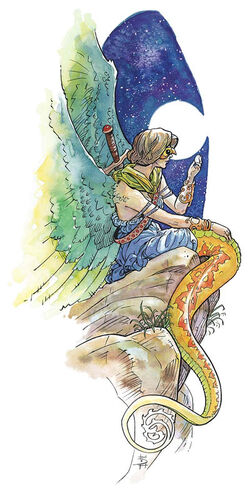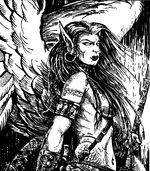Lillends (plural also seen as lillendi) were celestials native to Ysgard. They were also known to live in the Infinite Staircase, Arborea, and Limbo.[2][4]
The goddess Selûne sometimes transformed favored petitioners into lillendi as a reward for their faithful service in their mortal lives.[5] Lillendi were also known to serve the deities Sharindlar, Solonor Thelandira, Aerdrie Faenya, Corellon, Hanali Celanil, Labelas Enoreth, Lliira, and Oghma.[6][7]
Description[]
Lillendi had the arms, head, and torso of a beautiful humanoid, but had feathers in place of hair and wings. From the waist down their body was that of a serpent. The feathers and scales were all brightly colored and patterned. They were known to wear jewelry but never clothing.[2][1]
Abilities[]
Lillendi were capable of carrying up to 250 lb (110,000 g) while flying and could use their lower body to constrict smaller creatures when in a fight. Lillendi were also able to breathe underwater and were excellent swimmers.[2][1][3]
Lillendi were immune to poison and toxic gases, could cast a variety of bardic spells, and have several innate spell-like abilities. Additionally, they could fight with both their tail and held weapons.[2][1]
Ecology[]
As celestials, lillendi did not require food or drink. However, lillendi did enjoy eating material food, and when visiting material worlds would frequently treat themselves to local fare during their visit. After eating large quantities of meat, lillendi would go into a torpid state that could last hours or even days. Despite their eating habits, lillendi did not excrete anything.[2][8]
Lillendi did not mate or marry. Some scholars theorized that lillendi reproduced parthenogenically, as most lillendi had female upper torsos. However, some lillendi did have male torsos.[2][8][1]
It was rumored that lillendi could choose the hour of their death. This was called the Silent Hour, and came when the lillend had grown weary of life and service. Before the Silent Hour, lillendi would make their goodbyes; if they began fighting during the Silent Hour, they fought fiercely with calm and focused fury. Lillendi who died in ways other than the Silent Hour were said to bear expressions of despair. The Silent Hour was said to either be a gift from the gods of the moon or a curse from the powers of law.[2][8]
Society[]
Lillendi loved art and music and also valued unspoiled wilderness. They were normally peaceful, but the ill treatment of artwork or artist, or the destruction of wilderness, angered them. Lillendi were known to bear grudges for a long time.[2][1]

A lillend prophet
Lillendi also enjoyed learning astrological, ecological, and astronomical knowledge, and appreciated sages who could speak of such things. They were known to make alliances with rangers, bards, and druids to better protect wilderness.[2][1]
Social status among the lillendi depended on a system of mysteries and totem masks. The mysteries were akin to secret societies, and each held a specific piece of wisdom passed on to initiates. Each mystery group was associated with particular art forms and weapons. The more mysteries a lillendi was initiated into, the greater their social status. The masks were only tangentially related to the mysteries, as each mask design was unique to a family. The system was complicated, but the masks roughly indicated familial association.[2][8]
The lillends' love of art and creativity meant that they held the Infinite Staircase as their most sacred site. They were among its guardians, and threatening or harming the staircase would cause them to attack. While on the staircase, lillendi wore special, featureless masks.[9]

Lillendi did not get along with the shards that also served Selune. They hated modrons and devils, and were prejudiced against tieflings of diabolic heritage.[9]
Notable Lillendi[]
- Cattariina. Helpful guide and guardian of the pathway between the Gates of the Moon and the Infinite Staircase.[10]
Appendix[]
See Also[]
Further Reading[]
- Wolfgang Baur and Lester Smith (1994-07-01). Planes of Chaos. Edited by Michele Carter. (TSR, Inc). ISBN 1560768746.
- Jennifer Clarke Wilkes, David Eckelberry, Rich Redman (February 2003). Savage Species. (Wizards of the Coast). ISBN 0-7869-2648-1.
- Bruce R. Cordell, Gwendolyn F.M. Kestrel (July 2004). Planar Handbook. (Wizards of the Coast). ISBN 0-7869-3429-8.
Gallery[]
References[]
- ↑ 1.0 1.1 1.2 1.3 1.4 1.5 1.6 1.7 1.8 Skip Williams, Jonathan Tweet, Monte Cook (July 2003). Monster Manual v.3.5. (Wizards of the Coast), p. 168. ISBN 0-7869-2893-X.
- ↑ 2.00 2.01 2.02 2.03 2.04 2.05 2.06 2.07 2.08 2.09 2.10 2.11 2.12 Dale Donovan (May 1998). For Duty & Deity. (Wizards of the Coast), pp. 61–62. ISBN 0-7869-1234-0.
- ↑ 3.0 3.1 3.2 Ed Greenwood, Matthew Quinn, Samuel Offutt, Gregg Sharp, Lenard Lakofka, Roger Moore, Stephen Inniss, Kris Marquardt (February 1985). “Creature Catalog II”. In Kim Mohan ed. Dragon #94 (TSR, Inc.), p. 50.
- ↑ Monte Cook (1998). Tales from the Infinite Staircase. Edited by Skip Williams. (TSR, Inc), p. 4. ISBN 0786912049.
- ↑ Ed Greenwood, Eric L. Boyd (March 2006). Power of Faerûn. (Wizards of the Coast). ISBN 0-7869-3910-9.
- ↑ Sean K. Reynolds (2002-05-04). Deity Do's and Don'ts (Zipped PDF). Web Enhancement for Faiths and Pantheons. Wizards of the Coast. pp. 10–14. Archived from the original on 2016-11-01. Retrieved on 2018-09-08.
- ↑ Eric L. Boyd (November 1998). Demihuman Deities. Edited by Julia Martin. (TSR, Inc.), p. 83. ISBN 0-7869-1239-1.
- ↑ 8.0 8.1 8.2 8.3 Jon Pickens ed. (November 1996). Monstrous Compendium Annual Volume Three. (Wizards of the Coast), pp. 73–74. ISBN 0786904496.
- ↑ 9.0 9.1 Monte Cook (1998). Tales from the Infinite Staircase. Edited by Skip Williams. (TSR, Inc), pp. 14–15. ISBN 0786912049.
- ↑ Dale Donovan (May 1998). For Duty & Deity. (Wizards of the Coast), p. 20. ISBN 0-7869-1234-0.
Connections[]
| Angel (any good alignment) | ||
| Archon (lawful good) | Guardinal (neutral good) | Eladrin (chaotic good) |
Arcadian avenger • Asura • Bariaur • Couatl • Einheriar • Foo creature (Foo dog • Foo lion) • Harmonious choir of the words • Hollyphant • Ki-rin • Lillend • Moon dog • Pegasus • Shirokinukatsukami • Sliver • Unicorn (Celestial charger)
Related Creatures
Aasimar (Deva) • Celestial creature • Half-celestial



